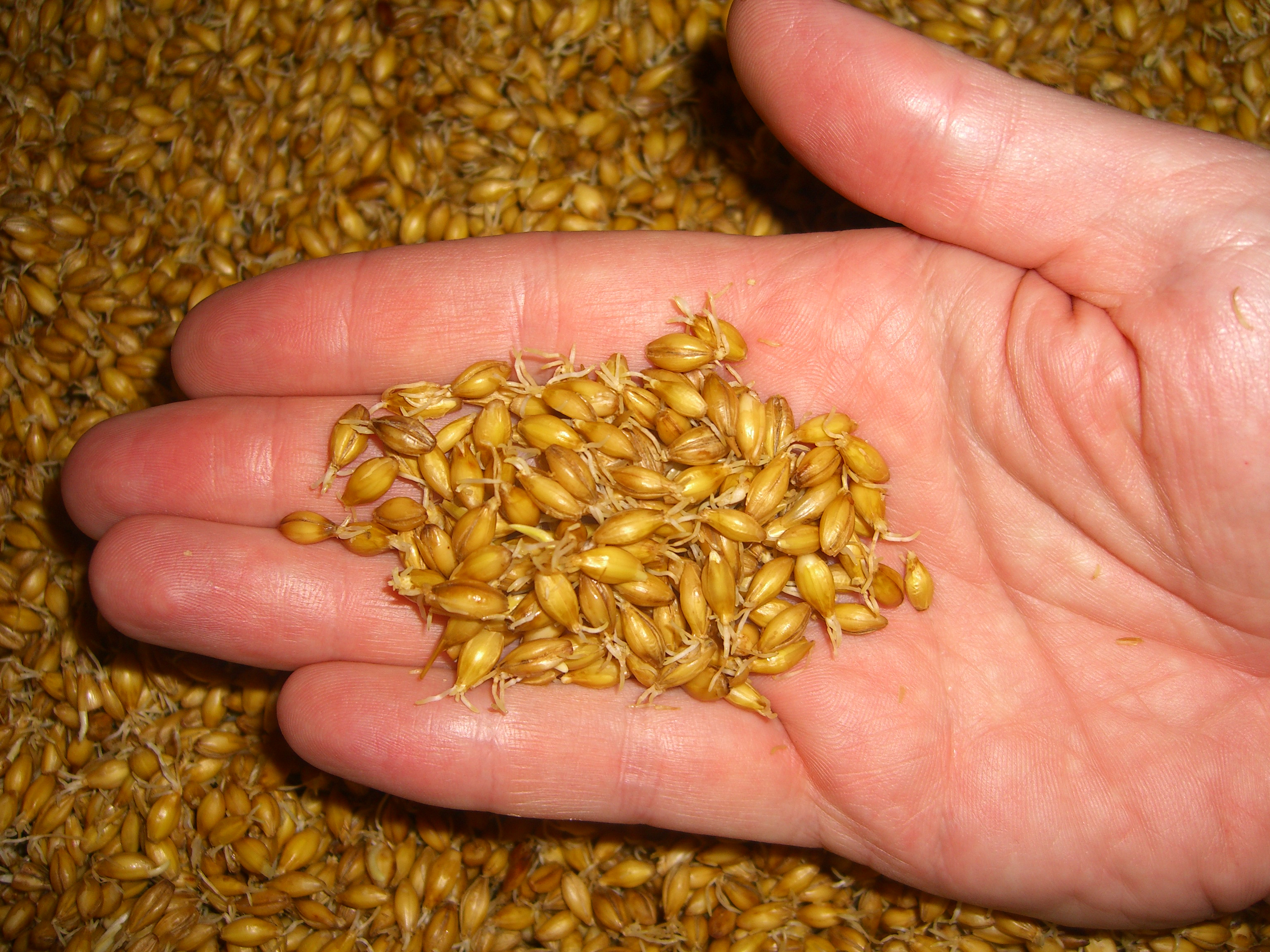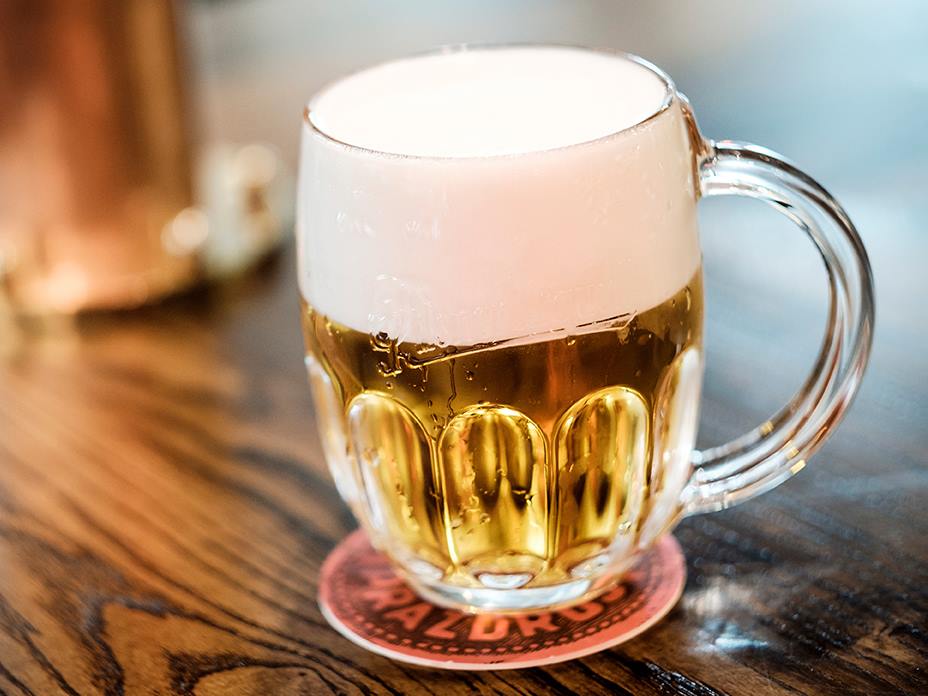|
American-style Lager
American lager or North American lager is pale lager that is produced in the United States. The pale lager-style beer originated in Europe in the mid-19th century, and moved to the US with German immigrants. As a general trend outside of Bavaria and the Czech Republic where the beers may be firmly hopped, pale lager developed as a modestly hopped beer, and sometimes used adjuncts such as rice or corn – and this was also true in the US. Worldwide, the best-known American lager is Anheuser-Busch InBev's Budweiser, though prominent brands are also made by MillerCoors (Coors Light, Miller Genuine Draft, etc.) Pale lager is the predominant choice among the largest brewing companies of United States of America, although it is not common in U.S. microbreweries. Likewise, in Canada the biggest-selling commercial beers, including both domestics such as Molson Canadian, Labatt Blue, Kokanee, Carling Black Label, and Old Style Pilsner, and imports such as Budweiser and Coors are ver ... [...More Info...] [...Related Items...] OR: [Wikipedia] [Google] [Baidu] |
Budweiser Beer
Budweiser () is an American-style pale lager, part of AB InBev. Introduced in 1876 by Carl Conrad & Co. of St. Louis, Missouri, Budweiser has become a large selling beer company in the United States. ''Budweiser'' may also refer to an unrelated pale lager beer, originating in České Budějovice, Czech Republic (in German, ) produced by the Budějovický Budvar brewery. There have been multiple trademark disputes between the two companies. Usually, either Anheuser-Busch or Budějovický Budvar are granted the exclusive use of the ''Budweiser'' name in a given market. Anheuser-Busch commonly uses the ''Bud'' brand for its beer when ''Budweiser'' is not available. The AB lager is available in over 80 countries, though not under the Budweiser name in places where Anheuser-Busch does not own the trademark. AB Budweiser is a filtered beer, available on draft and in bottles and cans, made with up to 30% rice in addition to hops and barley malt.Protz, R., ''The Complete Guide to W ... [...More Info...] [...Related Items...] OR: [Wikipedia] [Google] [Baidu] |
Carling Black Label
Carling Black Label is a lager distributed by Carling Brewing Company. History Although its original focus was on ale, Carling has brewed lager-style beers since the 1870s. In 1927, as part of a corporate re-branding under new president J. Innes Carling, the company renamed its Black & White Lager Black Label. Three years later, Carling was purchased by Toronto business tycoon E. P. Taylor, who merged it into his Canadian Breweries Limited (CBL), which grew to be the world's largest brewing company. Under Taylor, Black Label was promoted as CBL's Core product, flagship brand and went on to become the first beer to be brewed on a mass international scale, becoming particularly popular in Commonwealth countries such as the United Kingdom, Australia, New Zealand and South Africa. Canada In response to a shift in popular taste away from ale, Carling added a three-storey lager plant to their main London, Ontario, brewery in 1877. Carling's Lager (later renamed Carling's Bav ... [...More Info...] [...Related Items...] OR: [Wikipedia] [Google] [Baidu] |
Rationing
Rationing is the controlled distribution of scarce resources, goods, services, or an artificial restriction of demand. Rationing controls the size of the ration, which is one's allowed portion of the resources being distributed on a particular day or at a particular time. There are many forms of rationing, although rationing by price is most prevalent. Rationing is often done to keep price below the market-clearing price determined by the process of supply and demand in an unfettered market. Thus, rationing can be complementary to price controls. An example of rationing in the face of rising prices took place in the various countries where there was rationing of gasoline during the 1973 energy crisis. A reason for setting the price lower than would clear the market may be that there is a shortage, which would drive the market price very high. High prices, especially in the case of necessities, are undesirable with regard to those who cannot afford them. Traditionalist economi ... [...More Info...] [...Related Items...] OR: [Wikipedia] [Google] [Baidu] |
Barley Malt
Malt is germinated cereal grain that has been dried in a process known as "malting". The grain is made to germinate by soaking in water and is then halted from germinating further by drying with hot air. Malted grain is used to make beer, whisky, malted milk, malt vinegar, confections such as Maltesers and Whoppers, flavored drinks such as Horlicks, Ovaltine, and Milo, and some baked goods, such as malt loaf, bagels, and Rich Tea biscuits. Malted grain that has been ground into a coarse meal is known as "sweet meal". Malting grain develops the enzymes (α-amylase, β-amylase) required for modifying the grains' starches into various types of sugar, including monosaccharide glucose, disaccharide maltose, trisaccharide maltotriose, and higher sugars called maltodextrines. It also develops other enzymes, such as proteases, that break down the proteins in the grain into forms that can be used by yeast. The point at which the malting process is stopped affects the starch-to-enzym ... [...More Info...] [...Related Items...] OR: [Wikipedia] [Google] [Baidu] |
Saaz Hops
Saaz is a "noble" variety of hops. It was named after the Czech city of Žatec (german: Saaz). This hop is used extensively in Bohemia to flavor beer as the Czech pilsener. Saaz hops accounted for more than of total 2009 hop production in the Czech Republic. It is the main hop variety used in the production of global beer Stella Artois, a Belgian pilsner Pilsner (also pilsener or simply pils) is a type of pale lager. It takes its name from the Bohemian city of Plzeň (german: Pilsen), where the world's first pale lager (now known as Pilsner Urquell) was produced in 1842 by Pilsner Urquell Brewe .... Characteristics Saaz has a very distinctive flavour. When used in beer, the resultant aroma is very mild, earthy, herbal and spicy. Despite its popularity and noble pedigree, Saaz generally has a very low Alpha acid level and is not very effective as a bittering hop. This hop is generally used for Bohemian style lagers and pilseners. Another variety of Saaz hops has been pro ... [...More Info...] [...Related Items...] OR: [Wikipedia] [Google] [Baidu] |
List Of Hop Varieties
This is a list of varieties of hop (''Humulus lupulus''). As there are male and female plants, the flowers (cones) of the female plant are fertilized by the pollen of the male flowers with the result that the female flowers form seeds. These seeds are eaten by birds and hence spread over vast distances. Hops, specifically their female plants, have been grown as a commercial crop for the brewing industry for many centuries in many countries. The first documented mention of a hop garden is in the will of Pepyn III. The first breeding of different hop varieties took place at Wye College in Kent, England by E. S. Salmon in 1919 when he bred the varieties " Brewer's Gold" and " Bullion". As of 2012, there are around 80 varieties in commercial use around the world, and considerably more in development/trials. American Ahtanum brand YCR 1 cv Ahtanum brand YCR 1 cv is an aroma-type cultivar bred by Yakima Chief Ranches. It is used for its aromatic properties and moderate bittering. ... [...More Info...] [...Related Items...] OR: [Wikipedia] [Google] [Baidu] |
Two-row Barley
Barley (''Hordeum vulgare''), a member of the grass family, is a major cereal grain grown in temperate climates globally. It was one of the first cultivated grains, particularly in Eurasia as early as 10,000 years ago. Globally 70% of barley production is used as animal fodder, while 30% as a source of fermentable material for beer and certain distilled beverages, and as a component of various foods. It is used in soups and stews, and in barley bread of various cultures. Barley grains are commonly made into malt in a traditional and ancient method of preparation. In 2017, barley was ranked fourth among grains in quantity produced () behind maize, rice and wheat. Etymology The Old English word for barley was ', which traces back to Proto-Indo-European and is cognate to the Latin word ' "flour" (''see corresponding entries''). The direct ancestor of modern English ''barley'' in Old English was the derived adjective ''bærlic'', meaning "of barley". The first citation of the f ... [...More Info...] [...Related Items...] OR: [Wikipedia] [Google] [Baidu] |
Husk
Husk (or hull) in botany is the outer shell or coating of a seed. In the United States, the term husk often refers to the leafy outer covering of an ear of maize (corn) as it grows on the plant. Literally, a husk or hull includes the protective outer covering of a seed, fruit, or vegetable. It can also refer to the exuvia of insects or other small animals left behind after moulting. In cooking, hull can also refer to other waste parts of fruits and vegetables, notably the cap or sepal of a strawberry. The husk of a legume and some similar fruits is called a pod. Husking and dehulling Husking of corn is the process of removing its outer layers, leaving only the cob or seed rack of the corn. Dehulling is the process of removing the hulls (or chaff) from beans and other seeds. This is sometimes done using a machine known as a huller. To prepare the seeds to have oils extracted from them, they are cleaned to remove any foreign objects. Next, the seeds have their hulls, o ... [...More Info...] [...Related Items...] OR: [Wikipedia] [Google] [Baidu] |
Tannic Acid
Tannic acid is a specific form of tannin, a type of polyphenol. Its weak acidity ( pKa around 6) is due to the numerous phenol groups in the structure. The chemical formula for commercial tannic acid is often given as C76H52O46, which corresponds with decagalloyl glucose, but in fact it is a mixture of polygalloyl glucoses or polygalloyl quinic acid esters with the number of galloyl moieties per molecule ranging from 2 up to 12 depending on the plant source used to extract the tannic acid. Commercial tannic acid is usually extracted from any of the following plant parts: Tara pods ('' Caesalpinia spinosa''), gallnuts from ''Rhus semialata'' or '' Quercus infectoria'' or Sicilian sumac leaves ('' Rhus coriaria''). According to the definitions provided in external references such as international pharmacopoeia, Food Chemicals Codex and FAO-WHO tannic acid monograph only tannins obtained from the above-mentioned plants can be considered as tannic acid. Sometimes extracts from che ... [...More Info...] [...Related Items...] OR: [Wikipedia] [Google] [Baidu] |
Six-row Barley
Barley (''Hordeum vulgare''), a member of the grass family, is a major cereal grain grown in temperate climates globally. It was one of the first cultivated grains, particularly in Eurasia as early as 10,000 years ago. Globally 70% of barley production is used as animal fodder, while 30% as a source of fermentable material for beer and certain distilled beverages, and as a component of various foods. It is used in soups and stews, and in barley bread of various cultures. Barley grains are commonly made into malt in a traditional and ancient method of preparation. In 2017, barley was ranked fourth among grains in quantity produced () behind maize, rice and wheat. Etymology The Old English word for barley was ', which traces back to Proto-Indo-European and is cognate to the Latin word ' "flour" (''see corresponding entries''). The direct ancestor of modern English ''barley'' in Old English was the derived adjective ''bærlic'', meaning "of barley". The first citation of the f ... [...More Info...] [...Related Items...] OR: [Wikipedia] [Google] [Baidu] |
Pale Lager
Pale lager is a very pale-to- golden-colored lager beer with a well- attenuated body and a varying degree of noble hop bitterness. The brewing process for this beer developed in the mid-19th century, when Gabriel Sedlmayr took pale ale brewing and malt making techniques back to the Spaten Brewery in Germany and applied them to existing lagering methods, resulting in a less dark, red-colored beer. This technique was applied by Josef Groll, the famous Bavarian brewmaster, hired by Měšťanský pivovar in the city of Pilsen, Bohemia, Austria-Hungary (now Czech Republic) with local ingredients, resulting in the first pale lager Pilsner Urquell in 1842. The resulting Pilsner beers—pale-colored, lean and stable—gradually spread around the globe to become the most common form of beer consumed in the world today. History Bavarian brewers in the sixteenth century were required by law to brew beer only during the cooler months of the year. In order to have beer available ... [...More Info...] [...Related Items...] OR: [Wikipedia] [Google] [Baidu] |
Canadian Beer Awards
Beer was introduced to Canada by European settlers in the seventeenth century. The first commercial brewery was La Brasseries du Roy started by New France Intendant Jean Talon, in Québec City in 1668. Many commercial brewers thrived until prohibition in Canada. The provincial and federal governments' attempt to eliminate "intoxicating" beverages led to the closing of nearly three quarters of breweries between 1878 and 1928. It was only in the second half of the twentieth century that a significant number of new breweries opened up. The Canadian beer industry now plays an important role in Canadian identity, although globalization of the brewing industry has seen the major players in Canada acquired by or merged with foreign companies, notably its three largest beer producers: Labatt, Molson and Sleeman. The result is that Moosehead, with an estimated 3.8 percent share of the domestic market in 2016, has become the largest fully Canadian-owned brewer. Beer sales have been slugg ... [...More Info...] [...Related Items...] OR: [Wikipedia] [Google] [Baidu] |


.jpg)






